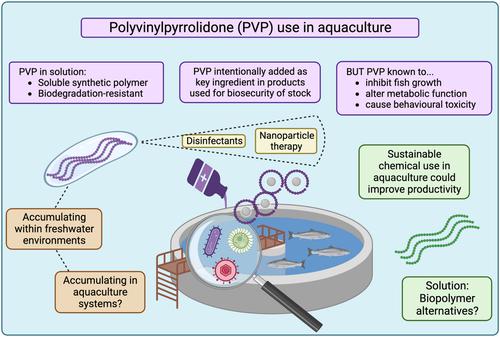当前位置:
X-MOL 学术
›
Rev. Aquacult.
›
论文详情
Our official English website, www.x-mol.net, welcomes your feedback! (Note: you will need to create a separate account there.)
Invisible plastics problem in intensive aquaculture: The case of polyvinylpyrrolidone
Reviews in Aquaculture ( IF 10.4 ) Pub Date : 2024-03-27 , DOI: 10.1111/raq.12910 Charlotte Robison‐Smith 1 , Jo Cable 1
Reviews in Aquaculture ( IF 10.4 ) Pub Date : 2024-03-27 , DOI: 10.1111/raq.12910 Charlotte Robison‐Smith 1 , Jo Cable 1
Affiliation

|
For over 70 years, aquaculture practices have relied on the same methods for biosecurity, however epidemics remain a primary limitation of global aquaculture yields with billions in revenue being lost every year due to disease. The intense nature of fish and shellfish farming necessitates the regular use of synthetic chemicals as both preventive and treatment measures, covering broodstocks to hatching and continuing through all stages of rearing. This practice, however, results in the contamination of rearing environments with persistent xenobiotics. A specific drawback in this foundational strategy for aquaculture biosecurity is highlighted in the current review: the consistent use of a water‐soluble polymer polyvinylpyrrolidone (PVP) across most, if not all, stages of rearing aquacultural livestock. PVP is used intensively within aquaculture practices as it is a ubiquitous additive within commercially available germicidal, prophylactic, and therapeutic products applied to control and prevent disease outbreaks within aquacultural farms. As a polymer, PVP is synthetic and biodegradation‐resistant, and has recently been described as an emerging contaminant of freshwater ecosystems. It is well documented that other persistent, synthetic polymer pollutants such as microplastics, reduce the fecundity, growth, and significantly deplete immune function in commercially important aquatic species. Despite this, intentionally added persistent soluble polymers, such as PVP, have not been considered in the context of aquaculture productivity. This review explores the potential impact of PVP on fish and shellfish highlighting the need for aquaculture to adopt sustainable chemical practices, drawing inspiration from advancements in nanotechnology applied within human medicines to address biosecurity protocol deficiencies.
中文翻译:

集约化水产养殖中的隐形塑料问题:以聚乙烯吡咯烷酮为例
70多年来,水产养殖实践一直依赖相同的生物安全方法,但流行病仍然是全球水产养殖产量的主要限制因素,每年因疾病而损失数十亿美元的收入。鱼类和贝类养殖的密集性要求定期使用合成化学品作为预防和治疗措施,涵盖亲鱼到孵化并持续整个饲养阶段。然而,这种做法会导致饲养环境受到持久性异生物质的污染。当前的综述强调了这一水产养殖生物安全基本策略的一个具体缺点:在水产养殖牲畜饲养的大多数(如果不是全部)阶段一致使用水溶性聚合物聚乙烯吡咯烷酮(PVP)。 PVP 在水产养殖实践中得到广泛使用,因为它是市售杀菌、预防和治疗产品中普遍存在的添加剂,用于控制和预防水产养殖场内疾病的爆发。作为一种聚合物,PVP 是合成的且具有抗生物降解性,最近被描述为淡水生态系统的新兴污染物。有充分证据表明,其他持久性合成聚合物污染物(例如微塑料)会降低具有重要商业价值的水生物种的繁殖力和生长,并显着削弱其免疫功能。尽管如此,在水产养殖生产力方面尚未考虑有意添加持久性可溶性聚合物,例如 PVP。本综述探讨了 PVP 对鱼类和贝类的潜在影响,强调水产养殖需要采用可持续的化学实践,并从人类药物中应用的纳米技术的进步中汲取灵感,以解决生物安全协议的缺陷。
更新日期:2024-03-27
中文翻译:

集约化水产养殖中的隐形塑料问题:以聚乙烯吡咯烷酮为例
70多年来,水产养殖实践一直依赖相同的生物安全方法,但流行病仍然是全球水产养殖产量的主要限制因素,每年因疾病而损失数十亿美元的收入。鱼类和贝类养殖的密集性要求定期使用合成化学品作为预防和治疗措施,涵盖亲鱼到孵化并持续整个饲养阶段。然而,这种做法会导致饲养环境受到持久性异生物质的污染。当前的综述强调了这一水产养殖生物安全基本策略的一个具体缺点:在水产养殖牲畜饲养的大多数(如果不是全部)阶段一致使用水溶性聚合物聚乙烯吡咯烷酮(PVP)。 PVP 在水产养殖实践中得到广泛使用,因为它是市售杀菌、预防和治疗产品中普遍存在的添加剂,用于控制和预防水产养殖场内疾病的爆发。作为一种聚合物,PVP 是合成的且具有抗生物降解性,最近被描述为淡水生态系统的新兴污染物。有充分证据表明,其他持久性合成聚合物污染物(例如微塑料)会降低具有重要商业价值的水生物种的繁殖力和生长,并显着削弱其免疫功能。尽管如此,在水产养殖生产力方面尚未考虑有意添加持久性可溶性聚合物,例如 PVP。本综述探讨了 PVP 对鱼类和贝类的潜在影响,强调水产养殖需要采用可持续的化学实践,并从人类药物中应用的纳米技术的进步中汲取灵感,以解决生物安全协议的缺陷。



























 京公网安备 11010802027423号
京公网安备 11010802027423号